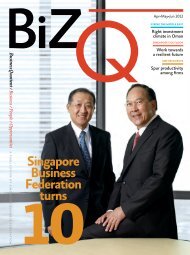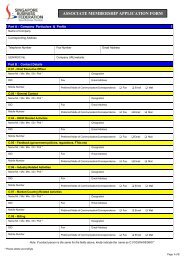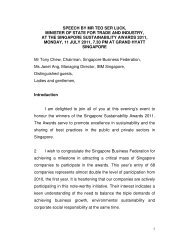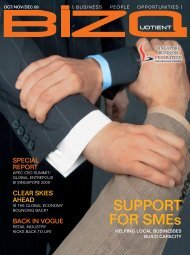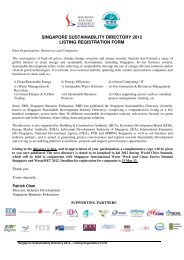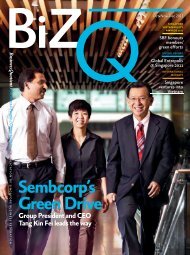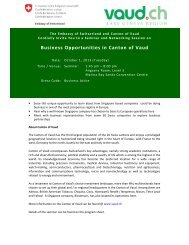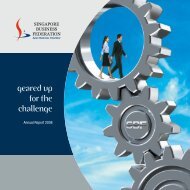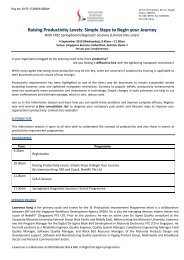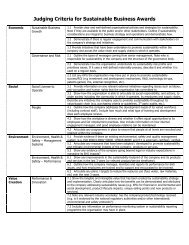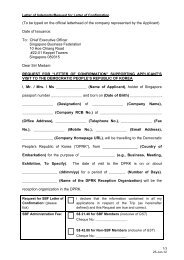00 Cover MrNgaiFong WF.indd - SBF Download Area - Singapore ...
00 Cover MrNgaiFong WF.indd - SBF Download Area - Singapore ...
00 Cover MrNgaiFong WF.indd - SBF Download Area - Singapore ...
- No tags were found...
Create successful ePaper yourself
Turn your PDF publications into a flip-book with our unique Google optimized e-Paper software.
Jul•Aug•Sep 2012FOCUS ON PRODUCTIVITYSustainable growthfor the futureINSPIRING TEAMWORKBusiness Quotient / Business / People / OpportunitiesA PUBLICATION OF SINGAPORE BUSINESS FEDERATIONBuilding synergyat workMANAGING BIZ ISSUESSME Committeeto focus on trendsand concernsEye OnASEANHong Kong’s tradehoncho Fong Ngaiwants closer ties withregional countries
Jul•Aug•Sep 2012Chairman’s Message1Leading to the Next Lap<strong>SBF</strong> started this year by leading the SMECommittee (SMEC) in assembling a 17-item “budget wish list”. Out of these, eightwere included in Budget 2012. The SMECcontinues to represent the SME communityin voicing its needs and concerns to theGovernment, through four sub-committeesfocusing on manpower and productivity,rising business costs, internationalisationand financing.Following the plight of low-wageworkers, <strong>SBF</strong> pledged its support to theNational Wages Council’s Guidelinesannounced in May for sustainable andinclusive economic growth. However,considering the uncertain globaleconomic outlook, as well as cost andother challenges faced by businesses, <strong>SBF</strong>will partner companies, trade associationsand chambers, unions and governmentagencies to ensure that wage increases arein tandem with increases in productivity.In February, <strong>SBF</strong> led an inaugural missionto Myanmar to help members gauge theeconomic environment and prospects inthis newly emerging market. This wasfollowed by missions to the United ArabEmirates, Kuwait, Nigeria, Benin, SriLanka and Turkey in May, as well as asecond Myanmar mission in June.Over the past months, the Federationhosted the Deputy Prime Minister ofthe Republic of Turkey at the Turkey-<strong>Singapore</strong> Business Forum, the PrimeMinister of New Zealand at a businessluncheon and the President of thePortuguese Republic at the Portugal-<strong>Singapore</strong> Business Forum. Theseevents provided the <strong>Singapore</strong> businesscommunity with a first-hand update ontrade and investment opportunities inthese markets.In June, <strong>SBF</strong> and Temasek Holdingsorganised the <strong>SBF</strong>-Temasek Forum onthe global economic environment, whichfocused on the eurozone crisis and itspossible impact on <strong>Singapore</strong> businesses.The apex chamber extends a warmwelcome to Ms Fang Ai Lian, whosucceeds Mr Sat Pal Khattar as chairmanof the <strong>SBF</strong> Board of Trustees (BOT). Wewould also like to welcome new BOTmember Mr Lucien Wong, and thank MrKhattar for his 10 years of service to <strong>SBF</strong>.We are expecting an equally busy sixmonths ahead. <strong>SBF</strong> will be organisingtwo major business forums – theRussia-<strong>Singapore</strong> Business Forumfrom Sept 24 to 27 and the GESBusiness Leaders’ Summit fromOct 23 to 25.The Federation will also becelebrating its 10 th anniversarywith a gala dinner in October.We invite you to share thisspecial occasion with us.Tony Chew Leong-CheeChairman<strong>Singapore</strong> Business Federation
206Jul•Aug•Sep 2012ContentsEconomy WatchHolding Steady inUncertain Waters<strong>Singapore</strong> focuses on growthin sectors like electronics andprecision engineering amidglobal uncertainty.10BiZ VoiceASEAN RegionSpurs InvestmentsRecent survey reveals thatfirms find the economiccommunity favourable forforeign ventures.14CommentaryStrategies forRetaining TalentBuilding intellectual capitalis an integral part of businessstrategy, and it beginsat the point of hiring.2024In BiZ WithHong Kong Sets ItsSights on ASEANMr Fong Ngai from theHong Kong Economic andTrade Office (ASEAN)warms ties with the region.InnovationsShooting forthe CloudsWebvisions’ cloud computingservices cater to companies’changing needs.16BiZ FeatureShaping <strong>Singapore</strong>’sProductivity<strong>Singapore</strong> steps up efforts to improveproductive capacity with more governmentinitiatives and training programmes.Getty ImagesABOVE: Factors such as skilled labour and innovative solutions will helpachieve sustainable growth in <strong>Singapore</strong>.
6Jul•Aug•Sep 2012Economy WatchHolding Steadyin UncertainWatersBiZQ looks athow <strong>Singapore</strong>stays focusedon sectoralgrowth andproductivityamid globaluncertainty.In mid-May, it wassobering to hear fromthe Ministry of Tradeand Industry (MTI) thatit was maintaining a GDPgrowth rate forecast of between1% and 3% for 2012 – comparedwith 4.8% growth for last year.When put in the context of thecurrent macroeconomic landscape,this is a silver lining.The US economy continues todemonstrate growth spurts, withno clear upward or sustainablegrowth trend. The crisis in Europecontinues unabated as most analystshave raised the probability of animminent Greek exit from theEurozone.Regional powerhouse Chinacontinues to exhibit an economythat is slowing. The Chinesegovernment has just lowered itsgrowth target for 2012 to 7.5% toreflect a declining trend of potentialgrowth, as well as to facilitate a shiftof growth engine from investmentto consumption.Mr Steve Brice, Chief InvestmentStrategist of Standard CharteredPrivate Bank, told BiZQ: “2012promises to be another volatile yearas we continue to work throughthe overhang of the global financialcrisis and the continuing crisis inEurope.”Still positiveBack home, MTI maintained itsforecast after it announced thatthe <strong>Singapore</strong> economy grew 1.6%on a year-on-year basis in the firstquarter of this year, compared to3.6% in the preceding quarter.On a quarter-on-quarterseasonally adjusted annualisedbasis, the economy expanded by 10%– reversing the 2.5% contraction inthe previous quarter.There are also other signsProductivitygrowth targetsThe National Productivity andContinuing Education Council’sthree main areas offocus include:Driving productivityinitiativesDeveloping a comprehensivenational ContinuingEducation & Training systemPromoting a cultureof productivity,innovation, learningand upgradingindicating a brighteroutlook for <strong>Singapore</strong>.The manufacturing sectoris starting to make acomeback, with leadingindicators pointing tostrong growth from thesecond quarter.Analysts say sparks arealso starting to fly fromthe electronics and precisionengineering sectors.Citigroup economist Kit WeiZheng said that while there couldbe bumps caused by a slowdown inthe GDP growth of China and theUS, electronics are restocking. Thisis evident as production levels arestill falling behind exports andthis will help cushion <strong>Singapore</strong>’sGDP growth.The construction sector alsoappears to be growing, largely aresult of a ramp-up in residentialconstruction activities. This hasresulted in economists predictingstronger GDP growth performancein the second half of this year.Eye on productivityUpon taking a more in-depth viewof the <strong>Singapore</strong> economy, it isclear the republic continues to beplagued by two key variables – highinflationary pressures (see side storyon MAS) and low productivity.
7NWC WAGE-RELATEDGUIDELINES1COMPANIES GRANTBUILT-IN WAGE INCREASESFOR 2012-2014.MAS: To allow<strong>Singapore</strong> dollarnominal exchangerate to rise<strong>Singapore</strong> needs to rely on productivityimprovements and innovation todrive sustainable growth.The latter is currently thehottest topic of discussion amongpolicymakers, businesses as wellas workers.As HSBC economist FredericNeumann put it in an April 2012report, productivity gains in<strong>Singapore</strong> is grounding to a halt,threatening the republic’s longertermsustainable growth.Amid the many dire indicators ofdeclining productivity in <strong>Singapore</strong>,a major proposal emerged recentlyto suggest that those earning below$1,5<strong>00</strong> a month should have theirsalaries increased by 50% over threeyears, while the wages of thoseearning $15,<strong>00</strong>0 or more should befrozen.This would enable those in thelower income group to raise theirproductivity levels and help therepublic address a growing problem– that of bridging the nationalincome divide.In response to this proposal, theNational Wages Council completedits deliberations on wage and wagerelatedguidelines for 2012/2013recently and recommended that:1 Companies grant built-in wageincreases for 2012/2013, takinginto account the prevailing labourmarket conditions, as well as theirrespective business performanceand prospects.2FIRMS REWARD EMPLOYEESTHROUGH VARIABLEWAGE COMPONENTS.2 Firms reward staff via variablewage components whereappropriate, in line with thecompany’s performance andworkers’ contributions.Reflecting the broader voiceof the business community, MrHo Meng Kit, CEO of <strong>Singapore</strong>Business Federation (<strong>SBF</strong>), who hasbeen assisting the <strong>SBF</strong>-led SMECommittee, noted: “Businesses arenot against lower-income workershaving a wage increase, especiallywith the rising costs of living in<strong>Singapore</strong>.“However, it is important howthis wage increase is anchored.We believe we should press onwith the current approach, wheretrade associations and chamberswork closely with the unions andgovernment agencies to spur groundlevelproductivity improvementsin companies. This requires moreeffort, but the result would bemore sustainable.”Broader initiativesAt the 54th session of the AsianProductivity OrganizationGoverning Body meeting in<strong>Singapore</strong>, Mr Lee Yi Shyan,Minister of State for Trade andIndustry, said the republic isnow redoubling efforts to raiseproductivity among its workforce.Going forward, <strong>Singapore</strong> willneed to rely less on factor inputsuch as labour supply; and more onproductivity gain and innovation todrive sustainable growth, he said.In 2010, <strong>Singapore</strong> set a targetof achieving productivity growthp.8Given that inflationary pressurescontinue unabated in <strong>Singapore</strong>,the Monetary Authority of<strong>Singapore</strong> said in April that it will“continue with the policy of amodest and gradual appreciationof the <strong>Singapore</strong> dollar nominaleffective exchange rate”.In sharing its latest policy stancesince October last year, the de factocentral bank said that it expectsinflationary pressures to remainelevated over the next few months.“This policy stance will helpanchor inflation expectations,ensure medium-term price stability,and keep growth on a sustainablepath,” it added.DBS has maintained thatinflation risks are still the concernfor <strong>Singapore</strong>, with the republichaving the “worst inflation profilein the region”.With this view, the bank isexpecting the US dollar to trade ataround S$1.26 at end 2012.Mr Ho Meng Kit, CEO,<strong>Singapore</strong> Business Federation“We believe weshould press onwith the currentapproach, wheretrade associationsand chamberswork closely withthe unions andgovernment agenciesto spur groundlevelproductivityimprovements incompanies.”SPH Library
10Jul•Aug•Sep 2012BiZ VoiceGetty ImagesASEAN RegionSpurs InvestmentsNew survey reveals region holds goodprospects for attracting investments,says ASEAN Business Advisory Council.The ASEAN region holdsgood prospects for drawinginvestments and manybusinesses consider how attractivethe region, as a whole, is forinvestment when planning theirventures in ASEAN countries.The recent findings from the2011-2012 ASEAN BusinessAdvisory Council (ASEAN-BAC)Survey on ASEAN competitivenessalso revealed that companiesattach relatively high importanceto the region’s efforts to achievean ASEAN Economic Community(AEC) by 2015.The survey, conducted byASEAN-BAC in collaboration withDr Wong Marn Heong, AssistantProfessor at the Lee Kuan YewSchool of Public Policy, collated405 responses from all 10 ASEANmember economies. The <strong>Singapore</strong>segment of the survey wassupported by the <strong>Singapore</strong>Business Federation (<strong>SBF</strong>).Increase in investmentAccording to the survey, 88% ofbusinesses planned to invest orincrease investments in at least oneASEAN country over a three-yearhorizon (2011-2014).The top investment destinationwas Indonesia, followed by Vietnam,<strong>Singapore</strong>, Thailand and Malaysia(see Figure 1).In addition, 36.5% of respondentsindicated an ASEAN countryas offering the best prospectsworldwide for their organisations’offshore direct investments overthe next three years.ASEAN’sattractiveness wasalso rated higher thanChina’s – both as a market forgoods and services and as aproduction location.Two-fifths of businessesconsidered the investmentattractiveness of ASEAN as awhole when planning their venturesin ASEAN countries over the nextthree years.The authors of the survey reportnoted that the finding might pointto a rising consciousness amongfirms of ASEAN’s initiatives tocreate an economic community,and of the opportunities that amore integrated ASEAN mightbring, as the region’s membergovernments implement moremeasures under the AEC Blueprintand step up their outreach efforts.It was noted that some twothirdsof respondents, whoseorganisations considered theoverall investment attractivenessof ASEAN, had at least generalINDONESIAVIETNAMSINGAPORETHAILAND(Percentage of respondents)MALAYSIADevelopingSMEsThe 2011-2012 surveyalso revealed the needsand concerns of smalland medium enterpriseson the importance andeffectiveness of governmentinitiatives to promote SMEdevelopment. The findingsrevealed the following issues:● Financing● Promotion of SME innovationsand creativity● Networking among SMEsin ASEAN● Business missions to otherASEAN countries● Information on opportunitiesfrom ASEAN and ASEAN-plusFTAs and FTA-related documents● Information on SME ServiceCentresknowledge of ASEAN policyinitiatives related to trade andinvestment, compared with aroundhalf of the respondents whoseorganisations made their investmentdecisions based on the attractivenessof individual ASEAN countries.Dr Robert Yap, <strong>Singapore</strong>member of ASEAN-BAC, noted:“It is important for policymakersin ASEAN to know what thebusiness community thinks andto respond to their concerns.” •ASEAN countries firms plan to invest in from 2011 to 201450 46 43 42 42 27 26 26 25 17PHILIPPINESLAOSCAMBODIAFindings from 2011-2012 ASEAN-BAC Survey on ASEAN competitivenessMYANMARBRUNEI
The RussianconnectionR<strong>SBF</strong> 2012 creates networking opportunities for thelocal business community.Gaining a footholdin Tianjin Eco-City11The theme for the upcomingRussia-<strong>Singapore</strong> BusinessForum (R<strong>SBF</strong>) 2012– Connecting Markets – reflects thebusiness-to-business opportunitieslinking Russia to Asia, especially<strong>Singapore</strong>.To be held at the Marina BaySands <strong>Singapore</strong> from Sept 24 to27 this year, the event is targetingnearly 1,<strong>00</strong>0 participants, thuscreating a platform to facilitate newbusiness opportunities betweenthese two markets.One of the objectives of thisforum is to cultivate both Russianpolitical and business communitiesthat will recognise and networkwith <strong>Singapore</strong> companies.In facilitating such networkingbetween local and Russianbusinesses, <strong>Singapore</strong> can be seen asa suitable destination among highnet-worthRussians for investment,wealth management and leisure.Raising market profileThe 24th Asia Pacific EconomicCooperation (APEC) Summit willbe held in Vladivostok in Russia,presenting the country withnew opportunities in trade andinvestment, which will result innew policies and trends.Thus, at R<strong>SBF</strong>, speakers will helpcompanies understand how to lookat their world, tap on opportunitiesand cope with challenges to betterconduct business.Russia-<strong>Singapore</strong> BusinessForum 2012Sept 24-27Marina Bay Sands● R<strong>SBF</strong> is a business forum that hasgenerated successful connectionsbetween Russia and <strong>Singapore</strong>.● <strong>Singapore</strong> is a key connectingmarket for businesses.● R<strong>SBF</strong> is Asia’s only leading businessand networking platform to bridgeRussia and <strong>Singapore</strong> so as to reachout to top business elites from otherkey emerging economies.Visit www.rsbf.org.sg for details.As drivers of economic growthincreasingly centre on emergingand fast-developing markets, theforum will explore the ConnectingMarkets theme with a strongfocus on Asia. The differentsessions during the forum willexplore business opportunities andchallenges in Russia, especially asPresident Vladimir Putin takes upthe mantle of leadership.In line with R<strong>SBF</strong>’s mission tohelp build business relationships,the forum will also have focusedsessions to engineer businessencounters on a one-to-one level.For certain sessions, the topics willinclude real estate as investmentvehicles, industrial parks as modelsof development and technology asways of collaboration betweenboth business communities. •<strong>Singapore</strong>-based firms looking toenter the rapidly growing northernChina market can tap on someS$9.5 million worth of assistance.IE <strong>Singapore</strong> announced recentlythat funding will be providedover a period of five years andwill be administered through theSino-<strong>Singapore</strong> Tianjin Eco-CityInvestment and DevelopmentCo Ltd – the master developer ofTianjin Eco-City.Officials said this assistanceaims to promote and encourage<strong>Singapore</strong>-based firms to establishand develop an overseas businessfoothold in the northern Chinamarket by leveraging on the Sino-<strong>Singapore</strong> Tianjin Eco-City.Ms Jamie Lim, Regional MarketingDirector, Scanteak“We believeTianjin Eco-Cityis the right placeto plant our basestep in China, fromwhich we willbe conducting athorough marketresearch anddetermining ourmarket strategies.”Getty Images
Jul•Aug•Sep 201212BiZ VoiceGlobal Entrepolis@ <strong>Singapore</strong> 2012Summit to capitalise on fast-changing markets.From Oct 23 to 25, <strong>Singapore</strong>will once again host theregion’s leading businesssummit – Global Entrepolis @<strong>Singapore</strong> (GES) – now in itsninth edition.Presented by the <strong>Singapore</strong>Business Federation (<strong>SBF</strong>), GES2012 will present its annual outlookon the global financial landscapein 2013 and provide an analysis ofthe impact of leadership transitionin major economies on regionalbusinesses.This summit brings theinternational business communitytogether to discuss the latestoutlook on global markets, businessmodel trends, innovative ideas andnew approaches to growth.Emerging trendsInternational speakers will alsodiscuss the global trends whichcould be game changers – suchas the issues of demographic andconsumption pattern changes ofrising Asian middle-classconsumers, risks to global supplychains and emerging technologieswhich may disrupt currentbusiness models.In addition, the summit is anexcellent networking (and businessmatching)platform for more than6<strong>00</strong> influential senior businessexecutives, entrepreneurs, highnet-worthindividuals, foundersand policymakers who attendGES each year.The summit will also exploreprospects in the mega infrastructurebuild-up of Asia, present an updateof the regional markets and lookinto the hot sectors and projects innine emerging regional economies.Visit www.globalentrepolis.comfor more details. •Global Entrepolis @ <strong>Singapore</strong> 2012Oct 23-25Resorts World Sentosa<strong>Singapore</strong> will once again host theregion’s leading business forum, nowin its ninth edition. Presented by<strong>SBF</strong>, this summit brings togetherthe business community for a seriesof discussions on the latest outlookon global markets, business modeltrends, innovative ideas and newapproaches to growth.GES BusinessLeaders SummitOct 23Global Financial and EconomicLandscape● Global Economic Outlook 2013– More of the Same?● Impact of Leadership Transitionsin Major Economies on theRegional Business Landscape● Thriving in Emerging Markets:How to Spot the WinnersGlobal Trends● Rethinking Global Supply Chains– Beyond Lean● The Rise of Asia’s Middle ClassConsumers – The Next Big Thing● Growth of the Asian Brands –How to Compete with theGlobal Icons?With more than 50 international speakers providing insights into global trends and regional markets ,GES will help participants understand how they can capitalise on fast-changing markets in theever-changing business landscape.Oct 24Market Insights● The Mega Asian InfrastructureBuild-up – Agent of Changeor a Bubble in the Making?● Can ASEAN Deliver on Its2015 Promise?● Europe – Beyond the Headlines:Investment Opportunities for theSmart Money● China – The Politics of Business:New Directions in 2013 and Beyond● India – Can It Overcome ItsGrowing Pains?Countries: Hot Sectors andOpportunities● ASEAN, Middle East and South Asia
14Jul•Aug•Sep 2012CommentaryStrategies forRetaining TalentEssential pointers for buildingintellectual capital in a company.Getty ImagesIn today’s challenging businessclimate, attracting and retainingtalent is increasingly difficult.And Mr Deepali Chaturvedi, Headof Southeast Asia at Reed SpecialistRecruitment, couldn’t agree more.He said that <strong>Singapore</strong> companiesoften find it easy to attract staff butharder to retain them.A growing number of companiesare now recognising that theiremployees are far more than justan overhead – they representintellectual capital with a tangiblevalue to the business. So, manycompanies today are looking to hirefrom a growing pool of talentedStrategicbusiness alignmentFIVE DRIVERS OF TALENTMANAGEMENT:SEARCHKnow who it is you want to look for.SIGNALCommunicate what theorganisation stands for.SPACEGive staff space to think innovativelyand creatively, and to speak up.SUPPORTGive employees the tools todo their work well.STRATEGIC ALIGNMENTAlign the above to theorganisation’s strategy.Source: Ernst & Young, <strong>Singapore</strong> Human Capital Summitindividuals whofavour job satisfactionand recognition.Recognisingtalented staffHowever, this intellectualcapital has to be aligned betweencorporate strategies and the goals ofindividuals within the organisation.This is where human capitalmanagement comes in.By recognising the value thathuman capital management bringsto the business structure, companiescan realise the following benefits:● Lower staff turnover● Better recruitment decisions● Closer alignment of strategy withjob development● Tangible financial return oninvestment (ROI)By putting in place apractice that allows workflow, projects, documents andcontact management to integrate,companies can utilise technologythat defines human capitalmanagement practices.Companies need to look beyondhuman resources as an expenditure.Human capital is an entity ofknowledge and assets that canbe capitalised upon to create astrategic value partner within theorganisation. Incorporating a newprocess methodology that increasesproductivity with expected ROIscontributes directly to a company’sfinancial health.Managing talentAccording to recent studiesconducted by Ernst & Young,there are five drivers of talentmanagement that senior executivesneed to identify:● Search – Access suitability of newstaff, and make an effort to knowwho it is you want and find theperson you are looking for.● Signal – Define and communicatewhat the organisation stands for,so that you attract the people youare looking for. Show that theorganisation cares for its employees.● Space – Give your staff the spaceto think innovatively and creatively,and to speak up. Do respect diversepeople and views.● Support – Give employees thetools to do their work, as well asthe emotional and moral support todo it well. Do give them the rightinformation to perform the jobwith clarity.● Strategic alignment – Ensurethat all the above are aligned withthe organisation’s strategy andbusiness outcomes.By successfully implementinga company-wide human capitalprogramme, companies can utilisethe intellectual capital representedby their employees. At the sametime, they can improve theirwork performance, embed humanresources as an organisationalvalue-add and, most importantly,recognise that people are a valuableasset that can drive profit. •
19-20SEPTEMBER2012RESORTS WORLD SENTOSAProf Dave UlrichBest-selling authorand world-renownedthought leaderHarish ManwaniUnilever, ChiefOperating OfficerLieutenant GeneralDavid HuntoonSuperintendent,United States MilitaryAcademy (West Point)Tracey FellowsMicrosoft, President ofAsia PacificChng Yi Ta?What If!, ChiefExecutive Officer AsiaGilbert GhostineDiageo, President ofAsia PacificGerardo AblazaManila Water,President & ChiefExecutive OfficerGill RiderCIPD (UK), PresidentHo Kwon PingBanyan Tree,Executive Chairmanand FounderJonathan SpectorThe ConferenceBoard, Chief ExecutiveOfficerDr Robert YapYCH Group,Chairman & CEOVicky BindraMastercard, Presidentof Asia Pacific, MiddleEast and AfricaZulkifli ZainiBank Mandiri,President DirectorAliza KnoxGoogle Asia Pacific,Managing Director,CommerceRegister now or find out more at our website: www.singaporehcsummit.comOrganisers:
16Jul•Aug•Sep 2012BiZ FeatureEconomic gyrationshave become morevolatile and pronounced.Major economies areexperiencing bouts ofmarginal economic growth andslowdowns. Uncertainty continuesto rule the day, amid a continuedslow bank run in some Eurozoneeconomies.Given this landscape, just aboutevery economy continues to wagethe war for talent with the aim ofattracting, retaining and nurturingthis valuable resource.In <strong>Singapore</strong>, some quartershave urged the private sectorand Government to use wageadjustments as an economic tool toachieve the desired goals in talentdevelopment and productivitygrowth.There is, however, a significantlygreater consensus on the useof productivity development asa means to achieve the goal ofcontinued economic growth.Focus on productivitySome of this debate occurred duringrecent discussions at the 54thsession of the Asian ProductivityOrganisation (APO) GoverningBody meeting in <strong>Singapore</strong> in Aprilthis year.In his opening address, MrSomdy Inmyxai, the APO Chair,emphasised the importance ofthe region in making even greaterefforts to improve productivityperformance and accelerate socioeconomicprogress in order toovercome the lingering globalfinancial crisis.The push for productivitygrowth is certainly gaining strongtraction in <strong>Singapore</strong>. As recent as2010, the Government announcedthat it will redouble its effortsto raise productivity, making afocused attempt to drive labourand innovation as economic factorstowards productivity gains andsustainable growth. The currentplan is to achieve productivitygrowth of 2% to 3% a year over thenext 10 years.Shaping<strong>Singapore</strong>’sAs Mr Lee Yi Shyan, Minister ofState for Trade and Industry andNational Development, said at theopening of the APO meeting: “Theneed for productivity drive remainsas relevant as before, if not more.”Need to upgrade and improveEchoing the same chorus at thenational level, Minister of State forFinance and Transport JosephineTeo said: “The Government willnot spare any effort in helping ourcompanies, especially the small andmedium enterprises, to upgrade andimprove productivity.”Ms Teo made this remark at thelaunch of a new multi-agency effortcalled PRIME to gear <strong>Singapore</strong>companies towards sustainableinnovation-led and productivitydrivengrowth.To achieve the newly setproductivity growth targets,<strong>Singapore</strong> has set up the NationalProductivity and ContinuingEducation Council to spearhead thenational productivity drive.The focus will be on drivingproductivity initiatives at thesectoral, enterprise and workerlevels; developing a comprehensive,first-class national ContinuingEducation and Training (CET)system; as well as promotingand entrenching a culture ofproductivity, innovation andProductivityGetty ImagesConcerted multi-party private sectorinitiatives, enlightened businesses andgovernment programmes are changing theface of productivity in <strong>Singapore</strong>.BiZQ takes stock.
17continuous learning and upgradingamong <strong>Singapore</strong>ans.Reiterating the importance ofproductivity growth in the contextof the recent national discussion,Mr Lawrence Leow, who heads the<strong>Singapore</strong> Business Federation-ledSME Committee, said increasingthe productivity of the workforce isessential to staying ahead.While the drive has been spurredat the national level, a key targetsegment will be home-grown smalland medium enterprises (SMEs)– a long-term growth driver of the<strong>Singapore</strong> economy.SMEs’ productivity initiativesSome firms acknowledge theconstraints, such as labourshortage in the marketplace, andhave leveraged on technology toovercome them.One such case is homegrownSwee Hong EngineeringConstruction Pte Ltd, which isusing iPhone and 3-D visualisationapplications to boost growth.Then, there are many SMEs thatrequire advisory services throughthe likes of national productivityprogrammes to spur them on andsuch organisations come fromtraditional industries in <strong>Singapore</strong>.One such programme helpingthese SMEs is led by theMr Lawrence Leow, Chairman of<strong>SBF</strong>-led SME Committee“An unmitigatedwage increasewithout productivityimprovementswill stifle growth.Productivity gainsshould comethrough job redesign,automation andskills upgrading.”PRIME strives to raise awareness on variousproductivity training programmes andgrants to equip companies with productivityand organisational development skills.Enterprise Development Centreslocated at the Chinese, Indian andMalay Chambers of Commerceand Industry, the Association ofSmall and Medium Enterprisesand the <strong>Singapore</strong> Manufacturers’Federation.Through such collaborations,home-grown S&W Engineeringwas advised to automate manualprocesses such as cutting,lifting and welding.The company, a specialistin heat transfer equipment forthe oil and gas industry, hasalso developed a specialisedtest machine for the sector. As aresult, it was able to increase itsproduction capacity by 10%.The introduction of newequipment has also reduced thecompany’s need for labour. Forexample, water-jet cutting resultedin 24% less labour cost than theearlier grinding methods used bythe company.Training and qualityAnother firm is Winson Press, aplayer who continues to grow inwhat many may consider a sunsetindustry in <strong>Singapore</strong> – print andpublishing.Mr Tan Jit Khoon, CEO ofWinson Press, told BIZQ that hiscompany had always wanted tomake lean manufacturing a wayof life.“There is always a way to getthings done better, faster andcheaper. We learn and upgradeourselves continuously, reengineerour business processesand strive for excellence,” saidMr Tan.p.18Getty Images
Jul•Aug•Sep 201218SPH LibraryBiZ FeaturePRIMESTANDS FORPRODUCTIVITY, RESILIENCEAND INNOVATION FORMANPOWER EXCELLENCE.It is a multi-agency effort to gear<strong>Singapore</strong> companies towardssustainable innovation-ledand productivity-driven growth.THE AIM:To drive productivity initiativesat the sectoral, enterprise andworker levels.To develop a comprehensive,first-class national ContinuingEducation and Training system.To promote and entrench aculture of productivity, innovationand continuous learningand upgrading.Winson Press recently decidedto participate in the initiativeled by the <strong>Singapore</strong> WorkforceDevelopment Agency (WDA),in which participants fromthe manufacturing and serviceindustries are supported with up to70% funding on training fees.The aim is to improveorganisational methodologies andproductivity.“During the three-monthconsultancy project implementation(phase), our people learnt andapplied methodologies to improvequality and productivity in workprocesses. The projects have helpedus to cut down significantly on manhoursand wastage in operations,”said Mr Tan.“The improved processes enable usto serve our clients faster and better.Our employees have been trained as‘productivity managers’ and they arecurrently equipped with the skills tocontinuously improve productivityat work. The programme hasdefinitely benefited us,” addedMr Tan. •<strong>SBF</strong>-led PRIMEto boost productivityIn a national coordinated effort todrive productivity in <strong>Singapore</strong>, theGovernment and industry leaders,including apex chamber <strong>Singapore</strong>Business Federation (<strong>SBF</strong>), have justlaunched the Productivity, Resilienceand Innovation for ManpowerExcellence (PRIME) programme.The initiative aims to gear<strong>Singapore</strong> companies towardssustainable innovation-led andproductivity-driven growth amida tight labour market and risingbusiness costs.Aside from <strong>SBF</strong>, the initiativeis supported by Human Capital<strong>Singapore</strong>, the <strong>Singapore</strong> WorkforceDevelopment Agency and theEmployment and EmployabilityInstitute.PRIME comprises productivityand innovation conferences,master classes on productivity andleadership, productivity training,project consultancy, variousHR <strong>Singapore</strong> Workforce SkillsQualifications modules as well asother components.About 10,<strong>00</strong>0 companies areexpected to benefit from thisprogramme over the next two years.Mr Ong Hock Leong,Managing Director ofSwee Hong EngineeringConstruction Pte Ltd“The employmentof technology andinnovations inconstruction hasgreatly improved ourproductivity. Wealways encourage ourteam to build a workculture that placesstrong emphasis onproductive work andcreative thinking.”ENHANCINGTECHNOLOGYThe use of technology is amongsome of the tools employed toraise productivity levels in manybusinesses.Swee Hong EngineeringConstruction Pte Ltd is one of manyhome-grown companies which areleveraging on a variety of tools andchannels to boost productivity.Given the labour-intensiveorientation of most constructioncompanies in <strong>Singapore</strong>, one wouldimagine that deploying smarttechnology would be a stretch.The company has takenadvantage of smartphone andvisualisation technologies to up theante in productivity – it has createdits own iPhone application.The in-house iPhone app wasdeveloped as a project managementtool, which includes a humanresource module for leaveapplication and a vehicle-usagemonitoringand asset-trackingmodule which allows the companyto track its vehicle movements,Managing Director Ong HockLeong told BiZQ.By implementing these appmodules to cover daily taskapplications that enable supervisors,project managers and themanagement in assigning tasks toemployees, the company was able totrack its business activities on a realtimebasis and, thus, enjoy higherproductivity levels.Concurrently, it also customisedand implemented its own BuildingInformation Modelling (BIM) toolto provide better visualisation ofconstruction sites and surroundingstructures and buildings.As a result, it was able to obtain amore reliable digital representationof the construction methodsavailable for design decision-making,high-quality construction documentproduction, construction planningand performance predictions.“The employment of technologyand innovations in constructionhas tremendously improved ourproductivity during the tenderstage,” said Mr Ong.
<strong>SBF</strong> Mentor Clubreaches outMentorship programme provides knowledge transferto SME members.In his speech at theErnst & YoungEntrepreneur ofthe Year 2011 event,Mr Teo Chee Hean,Deputy Prime Ministerof <strong>Singapore</strong>, encouragedthe country’s businessleaders and successfulentrepreneurs tocontribute to the businesscommunity by participating invarious mentorship platforms.He said he hoped to build upa robust mentoring ecosystemin <strong>Singapore</strong> and, as an example,highlighted the <strong>Singapore</strong>Business Federation’s (<strong>SBF</strong>)Mentorship Programme, whichlinks experienced business leaderswith growth-oriented enterprises.This initiative aims to provide asounding board on their growthstrategies.Several successful businessleaders who were interviewedduring the event said they foundmentoring to be a fulfilling andrewarding endeavour, as suchenriching programmes allow themto share their business and lifeexperiences with others.The <strong>SBF</strong> Mentorship Programmeis a joint initiative between <strong>SBF</strong>and SPRING <strong>Singapore</strong> to helpcompanies become globallycompetitive through coaching,accelerated learning and effectivetransfer of knowledge.As this programme is designedwith a mentor-mentee matchingcapability, it offers a good platformfor SMEs to receive professionalguidance, exchange best businesspractices and adopt new businessmanagement skills from eminentbusiness leaders in <strong>Singapore</strong>.Some of the benefits of the <strong>SBF</strong>Mentorship Programme include:● Cultivating a conduciveenvironment for innovative crosslearning.● Building stronger leadership andmanagement skills in executivemanagement.● Facilitating the adoption ofbusiness best practices to acceleratebusiness growth.● Acquiring new businessopportunities and market access.Mr Shabbir Hassanbhai,Director of Indo StraitsTrading Co Pte Ltd, hasbeen an active memberof the <strong>SBF</strong> Mentor Club since theprogramme was launched in 2010.He is also an <strong>SBF</strong> council memberand vice-chairman of <strong>SBF</strong>’s MiddleEast Business Group.Mr Hassanbhai shared hisrewarding experience in the <strong>SBF</strong>Mentorship Programme with BiZQ.Q When did you first join the<strong>SBF</strong> Mentor Club?I was invited to participate in the<strong>SBF</strong> Mentorship Programme onAug 16, 2010. The programme inpartnership with SPRING waslaunched in September that year.Q Why did you decide to becomea mentor?I was a beneficiary of mentorshipwhen I was studying to be anaccountant and later in the familybusiness in recycling metals. Whathas always motivated me andmade me decide instantly to be amentor is the desire to share theconviction that one cannot teachpeople to be creative and haveideas; that is innate. What can bedone is to create an environmentwhere that is encouraged. The otherthing is when one has an idea, hecan be taught how to evaluate it– whether it is likely to succeed ornot – and come up with solutionsor suggestions to help increase thelikelihood of success. The <strong>SBF</strong>-SPRING partnership would anideal platform to engage companies,especially family-owned businesses,in this process.Q In your opinion, what does it taketo become a good mentor?Maturity and self-awarenessare, in my experience, essentialprerequisites for giving measuredadvice to others. In fact, a mentoringrelationship is a two-way process,with the person giving the advicelearning as much as, if not morethan, the one seeking it. In fact,I find that the greatest learningpoint in a mentoring relationship isalways about the people themselves.Based on their successes and failuresin life, they can hopefully sharelessons learnt about their strengthsand weaknesses.Q How do you feel to know thatyou’ve helped another memberduring the mentoring sessions?The three member companies thatI am mentoring now have beengreatly enriching experiences. Asmy passion is in the family-runbusinesses, to be able to discussabout what works and what doesn’tin such a business has been mostfulfilling, as the firms begin toevaluate Asian monolithic beliefsystems with a new perspective. •19Getty Images
20Jul•Aug•Sep 2012In BiZ WithHong Kong SetsIts Sights onASEANThe special administrativeregion is keen to join theASEAN-China community.Charles Chua
Hong Kong is puttingmore focus on tieswith ASEAN as theregion has seen tremendousgrowth over the past few years.Today, ASEAN has becomeHong Kong’s second largesttrading partner, surpassing theEuropean Union.Hong Kong is also gearingup to join the ASEAN-ChinaFree Trade <strong>Area</strong> (ACFTA) andformally proposed this to theSecretariat of the Associationof South East Asian Nations(ASEAN) last November.ACFTA was realised on Jan 1,2010 and, today, over 89% oftotal tariff lines of the ASEAN-6(Brunei, Indonesia, Malaysia,Philippines, <strong>Singapore</strong> andThailand) and China are nowtraded duty-free.Hong Kong’s interest injoining ACFTA is driven by thefact that it is the world’s largestfree trade area by consumerTAKING CHARGEMr Fong NgaiDirector, Hong Kong Economicand Trade Office (ASEAN)● Joined the Hong Konggovernment as administrativeofficer in 1995 and wasappointed in 1998 as assistantdirector-general of theHong Kong Economic andTrade Office in London.● Joined the Home Affairs Bureauin late 2<strong>00</strong>1 to take charge ofthe arts and cultural policies,including preparatory work forthe development of the WestKowloon Cultural District.● Served as assistantcommissioner for labour.market size and the third largest interms of combined GDP.In addition, joining ACFTAwould not only enable HongKong to develop closer economiccooperation with its neighbours,but also contribute to trade creation,investment flow and furtherregional economic integration.This would be a win-win situationfor all parties concerned.Developing economic andtrade tiesMr Fong Ngai, Director of the HongKong Economic and Trade Office(ASEAN), or HKETO, said this iswhere the role of the office comes in.He joined HKETO last July and,before this appointment, servedas the assistant commissioner forlabour in the Government of theHong Kong Special AdministrativeRegion.The HKETO aims to furtherdevelop government-to-governmentrelations and liaise with relevantgovernment bodies, such as theMinistries of Foreign Affairs andCommerce.It also keeps track of majorgovernment policies, providesupdates on the latest politicaldevelopment in the region and helpsfacilitate visits by Hong Kong’ssenior officials to the region.Mr Fong said HKETO aimsto promote economic and tradecooperation and investmentbetween business communities inthe region which are looking tostart or expand their businesses inHong Kong or in mainland Chinavia Hong Kong.It also fosters bilateral relationsbetween Hong Kong and ASEAN,facilitating overseas investors to tapinto the opportunities offered bythe special administrative region’sstrategic position as an internationalfinancial centre and its developmentas China’s renminbi offshorebusiness centre.Hong Kong plays a strategic roleas the trade and logistics network inthe East Asia region, due to its roleas an international financial centre,a free port and logistics hub, as wellas a trade and business centre.Trading partnersASEAN IS HONG KONG’S2nd largestTRADING PARTNERAFTER CHINA.<strong>Singapore</strong>, Thailand, Malaysia,the Philippines, Vietnam andIndonesia are among theTOP 20INTEREST IN JOININGACFTAACFTA is world’s largest free tradearea by market size and the thirdlargest in terms of combined GDP.Becoming part of ACFTA wouldenable Hong Kong to develop closereconomic cooperation with itsneighbours, and contribute to tradecreation, investment flow and furthereconomic integration.ASEAN is Hong Kong’s secondlargest trading partner after China.<strong>Singapore</strong>, Thailand, Malaysia, thePhilippines, Vietnam and Indonesiaare among Hong Kong’s top 20trading partners.Hong Kong has signed free tradeagreements with other importanttrading partners, as well as 29agreements on avoidance of doubletaxation with other countries,including Brunei, Indonesia,Thailand and Vietnam, to pavethe way for further economiccooperation.In April, Malaysia and theHong Kong signed a DoubleTaxation Avoidance agreementthat would reduce taxes, avoiddouble taxing for residents in bothplaces and allow authorities toexchange taxpayers’ informationto prevent fiscal evasion.p.2221
22Jul•Aug•Sep 2012In BiZ WithIn Thailand, the trade valuebetween the two economiesexceeded US$15 billion (S$19billion), a 7% increase year on year.The country is also lookingat positioning Hong Kong as aspringboard to reach the market inthe Chinese mainland. Last year,16.7% of Thailand’s trade with themainland was routed throughHong Kong.The special administrative regionis looking at closer ties with Bruneitoo. Last April, trade officials fromboth places said they hoped tofacilitate opportunities to createtrade awareness between the twobusiness communities.Developing economies such asVietnam, Cambodia and Indonesiaare attractive destinations forHong Kong entrepreneurs,especially in the retail, propertyand telecommunication sectors.There is good potential for agreater flow of investmentbetween these emerging marketsHong Kong FestivalHong Kong is celebrating its 15 thanniversary of the setting up of theHong Kong Special AdministrativeRegion. To mark this specialoccasion, the Hong Kong Economicand Trade Office (ASEAN) and itspartners are organising a series ofand Hong Kong. In fact, the specialadministrative region is Cambodia’ssecond largest trading partner.Vietnam-Hong Kong traderelations have seen strong growthas well. The two-way trade turnoverreached US$8.4 billion last year and,in the first two months of this year,the figure was US$526.4 million– an increase of 103.4% year on year.Vietnam’s exports to Hong Kongconsists mainly of electronic andspare parts, cables, rice as well asseafood products.<strong>Singapore</strong> and Hong Kong areeach other’s fifth largest tradingpartners. The average annualgrowth rate in bilateral tradebetween Hong Kong and <strong>Singapore</strong>was 6% from 2<strong>00</strong>7 to 2011, withtotal trade value reaching US$39.9billion in 2011.Hong Kong is also <strong>Singapore</strong>’ssecond largest export market,while the republic is Hong Kong’slargest supplier of petroleum oilsand oil products. •events in <strong>Singapore</strong> to showcaseHong Kong’s business communityand its arts and culture, withcultural performances, gastronomicexperiences, a business forum, agala dinner, dragon boat racing andother events to look forward to.PAVING THEWAY FORBUSINESSSet up in 1995, the Hong KongEconomic and Trade Office(ASEAN), or HKETO, fostersbilateral relations between HongKong and all 10 ASEAN membercountries. The office assistsbusinesses looking to start orexpand their operations in HongKong or in mainland China via HongKong. It also promotes arts, culturaland educational exchanges betweenHong Kong and ASEAN.HKETO collaborates with twostatutory boards – the Hong KongTrade Development Council andthe Hong Kong Tourism Board – topromote the special administrativeregion as a good business locationand a must-go tourist destination.Hong Kong Economic and TradeOffice (ASEAN) of the Governmentof the Hong Kong SpecialAdministrative Region#34-01 Suntec Tower Two,9 Temasek Boulevard,<strong>Singapore</strong>E-mail: hketo_sin@hketosin.gov.hkWillie Tan, Deputy Headof Investment PromotionContact: +65 6338 1771E-mail: willie_tan@hketosin.gov.hkWinsston Chu angEVENT DATE VENUEHong Kong-inspired menu by <strong>Singapore</strong>’scelebrity chef Willin LowPrelude to the Hong Kong Wine & Dine Month 2012Spirits Play: A work by Asian theatre mastersDanny Yung from Hong Kong and Makato Satofrom JapanPresented by <strong>Singapore</strong>’s Theatre PracticeGala dinner in celebration of the 15 th anniversaryof the establishment of the Hong Kong SpecialAdministrative RegionHong Kong-ASEAN Business ForumOct 12-31Oct 25-28Oct 30-31Wild RocketRestaurantThe Joyden Hall,Bugis+The FullertonHotel*Hong Kong Dragon Boat Race Nov 4 <strong>Singapore</strong> River* Subject to confirmationInvest Hong Kong (InvestHK) isa department of the Hong KongSpecial Administrative RegionGovernment established in July2<strong>00</strong>0 with private sector expertise.It provides complimentary advisoryservices to help foreign companiesset up their businesses and expandtheir operations in Hong Kong.InvestHK 投 资 推 广 署25/F Fairmont House,8 Cotton Tree Drive,Central, Hong KongContact: +852 3107 1<strong>00</strong>0E-mail: enq@investhk.gov.hk
We can helpyou navigateinternationalbusinesspayments.A simple payment platformfor efficient paymentsto suppliers.$Competitiveexchangerates.A suite of currencyrisk managementsolutions.Our specialists will manageyour transactions fromstart to finish.Contact us now.Discover how our payment specialists can help streamline your payment process.Phone: 6494 8231Read a related article on “Foreign Exchange Risk Management” atwww.business.westernunion.sg/resource-centre© 2012 Western Union Holdings Inc. All rights reserved.Western Union ® Business Solutions is an operating division of The Western Union Company. Western Union acquired Travelex <strong>Singapore</strong> Pte Ltd and Travelex Global FinancialServices (<strong>Singapore</strong>) Pte Limited in 2011. Services in <strong>Singapore</strong> are provided by Travelex <strong>Singapore</strong> Pte Ltd and Travelex Global Financial Services (<strong>Singapore</strong>) Pte Limited(collectively referred to as “WUBS” or “Western Union Business Solutions”). Western Union ® Business Solutions is an operating division of The Western Union Company.“Travelex” is a registered trademark of Travellers Exchange Corporation Limited and is used by Travelex Global Business Payments Limited and its affiliates under license.This brochure has been prepared solely for informational purposes and does not in any way create any binding obligations on either party. Relations between you and WUBS shall begoverned by the applicable terms and conditions provided to you before you trade. No representations, warranties or conditions of any kind, express or implied, are made in this brochure.
24Jul•Aug•Sep 2012InnovationsShooting forthe CloudsSMEs have the most to gain from cloud computing,a virtual IT delivery service that allows firms tofocus on what they do best, says Webvisions GroupCEO Poh Mui Hoon. Francis Kan reports.When a local companyselling media contentonline faced anunexpected spike in demand forits products, it easily ramped upits computing capacity to dealwith the additional load using avirtual technology known as cloudcomputing.More importantly, it was ableto scale down again when demandreturned to normal, saving theneed to invest in a costly physicalserver that would becomeredundant once the temporarysurge in activity subsided, said MsPoh Mui Hoon, Group CEO ofWebvisions Pte Ltd, a <strong>Singapore</strong>basedcompany that provides cloudcomputing services.“Cloud computing gives you theflexibility to stretch or contractyour compute or storage servicesas demand for your business goesup or down,” she said in aninterview with BiZQ.“If you have a big project andrequire an increase in computepower only for six months, with thecloud, you don’t have to make a bigcapital investment to cater to that.”In an increasingly erraticbusiness environment wheredemand becomes harder to predict,having an information technologyinfrastructure that tracks the ebband flow of your company’sactivity is critical.That explains the appeal of cloudcomputing, a highly scalable andcost-efficient service that deliverscomputing and storage capacityvirtually to end users, and whichhas caught on like wildfire in thecorporate world in recent years.Webvisions, a leader inproviding web-hosting servicesMs Poh Mui Hoon, GroupCEO of Webvisions“Cloudcomputing givesyou the flexibility tostretch or contractyour compute orstorage services.If you have a bigproject and requirean increase incompute power onlyfor six months, withthe cloud, you don’thave to make a bigcapital investment tocater to that.”
to companies in the region, is nowtaking the lead in offering cloudservices to its base of customersthroughout the Asia-Pacific.Focus on core businessWhile many multinationals andlarge local companies have adoptedthe cloud concept, the challengenow is to convince smaller firmsof the technology’s benefits, saidMs Poh, who took over the reinsof Webvisions in January after aneight-year stint as CEO of electronicpaymentfirm NETS.Small and medium enterprises(SMEs) would be better servedoutsourcing their IT functionsthrough the cloud to a third party,freeing up valuable resources toconcentrate on their core businessactivities.What can cloudcomputing do foryour business?Cloud computing involvesdelivering computing and storageservices virtually to businesses.The nature of the service meansbusinesses can save on investingin costly physical IT infrastructure,while capacity is easily scalableaccording to a user’s needs.For example, an e-commercebusiness which consists of twoservers may require an additionaltwo servers to handle the load of anew product launch in a particularmonth.Using the cloud, the companycan purchase CPU, RAM and otherresources equivalent to thoseadditional two servers for the monthof the product launch.Cloud computing offers SMEsthe availability of enterprise-classinfrastructure – including servers,routers and firewalls – without theneed to fund the required capitalexpenditure. You pay only for theadditional resources when youneed it, thus reducing your totaloperational costs.“Mid-tier companiescan derive a lot ofbenefits from thecloud, because theirfinances don’t allowthem to make bigcapital expenditureson IT infrastructure ormanpower. They alsohave a harder timeattracting IT talent,”said Ms Poh.“Cloud computingallows them to focuson their core business,which is where their competitiveadvantage is.”She related the story of a clientwho had decided to develop itsown human resource (HR) systemin-house, a decision which meantit was spending less time selling itsown services.“My question to the client was:What’s so unique about your HRportal that you can’t outsource to apartner? Doing so would makethings easier for the firm,” she said.Education is keyMs Poh’s aim now is to spread theword to a larger segment of SMEswho have yet to experience thebenefits of doing business throughthe cloud. The key is to changemindsets among less tech-savvyCEOs through more education– something Webvisions is wellplaced to do.While the company’s diverseclient base includes multinationalslike DHL, Microsoft and Johnson &Johnson, it has also been providingits web-hosting and related servicesto SMEs in the region since itsinception two decades ago.Currently, it operatesin seven markets in the Asia-Pacific: <strong>Singapore</strong>, India, Malaysia,Hong Kong, New Zealand,Australia and China.“The challenge is to make(SMEs) understand what thetechnology can do for them. Theconcept of the cloud is not veryclear to them. There is also the issueof overcoming concerns regardingsecurity,” she said.Ironically, the company’s physicalWEBVISIONSLeader in providing webhostingservices to companiesin the following markets:SINGAPOREINDIACHINAHONG KONGAUSTRALIANEW ZEALANDMALAYSIAMultinational clients include:MICROSOFTDHLJOHNSON & JOHNSONThe company plans toboost its cloud offering by makingmore applications availableto its customers through itsvirtual platform.presence in these markets gives it anedge over rivals in a business thatthrives on being virtual.Webvisions’ proximity to itscustomers means being able torespond to their needs quicklyas well as in a manner they arecomfortable with.“We are regional but we alsounderstand the nuances of eachcountry we operate in. You aretalking to staff who are culturallydiverse enough to be able to handleclients’ needs,” she said.In the longer term, the companyis looking to boost its cloud offeringby making more applicationsavailable to its customers throughthis virtual platform. This involvesbringing more partners on boardto develop applications, such as HRsystems and productivity suitesthat would continue to extendWebvisions’ value offerings.“Cloud computing is anevolution from our hosting-servicesbackground. It gives us a newcapability of helping and supportingour clients,” said Ms Poh. •25
26Jul•Aug•Sep 2012InnovationsRohde & Schwarzsets up Asian hubCompany to expand capabilities in knowledge transfer,supply chain management and engineering R&D.NEXT-GENERATIONTECHNOLOGIES● Near Field Communication (NFC)This is a new short-range, standardsbasedwireless connectivitytechnology that is based on radiofrequency identification. NFC usesmagnetic field induction to enablecommunication between electronicdevices in close proximity. It enablesusers to perform intuitive, safe andcontactless transactions, access digitalcontent and connect elec tronicdevices simply by touching orbringing devices closer to one another.Rohde & Schwarz recentlyannounced that it hasinvested S$58 million in itsfirst global hub outside Germany atChangi Business Park. This is part ofan S$85 million investment by thetest system company in <strong>Singapore</strong>over the next three years.The 12,747 sq m facility willbe Rohde & Schwarz’s regionalheadquarters and will house Rohde& Schwarz Asia – a global hub forR&D, engineering and productionin the region. The seven-floorbuilding is a state-of-the-art GreenMark Platinum building and isdesigned by local firm ForumArchitects Pte Ltd. Construction isexpected to be completed by the endof next year.The company is a global supplierof solutions in the fields of test andmeasurement, broadcasting, radiomonitoring and radio location, aswell as secure communications.With the worldwide boom inconsumer electronics, demand forfaster product development cyclesand the adoption of new technologylike Near Field Communication,Long Term Evolution and DigitalTerrestrial Transmission, the firm’sinvestment in <strong>Singapore</strong> marks astrategic milestone in strengtheningits presence in Asia.The company is expandingits existing system engineeringoperations to include other keyactivities and functions that arenormally conducted in Munich.These include product charterresponsibility, full-scale R&D,production and supply chain.Since its start-up in <strong>Singapore</strong>in 1997, the company has grownexponentially from a staff strengthof six to that of 350 today, with theramp-up of vital system engineeringoperations. About 1<strong>00</strong> to 150 newjobs in these functions will beadded with the completion of thenew building.Closer cooperation between theMunich headquarters and <strong>Singapore</strong>would enhance product feedbackbetween Asian customers and itsR&D development in <strong>Singapore</strong>.The company’s solutions addressdiverse market segments, suchas wireless communications, thebroadcasting and electronicsindustry, aerospace and defence,homeland security and criticalinfrastructures. •● Long Term Evolution (LTE)This is the technology for networkoperators to deliver mobilebroadband data and high-speedInternet access. With the first LTEnetworks successfully startingcommercial operations, furtherenhancements will becomeincreasingly important in providingan evolutionary path towards a true4G system, with LTE-Advanced.● DVB-T2This is a digital terrestrial transmissionsystem developed by the DVBproject. It introduces the latestmodulation and coding techniquesto enable the highly efficient useof the valuable terrestrial spectrumfor the delivery of audio, video anddata services to fixed, portable andmobile devices. The technology canbe used to simultaneously deliver awide range of services, from MobileTV and IPTV to HDTV and 3DTV.Satellite navigationGlobal navigation satellite systemstransmit satellite signals that canbe used for location and navigationpurposes around the world. Thebest-known system is the GlobalPositioning System (GPS) whichis operated by many governments.Europe’s own global navigationsatellite system Galileo was setup last year and is currently inoperation.
28Jul•Aug•Sep 2012Inside <strong>SBF</strong><strong>SBF</strong> Leads SMECommittee tothe Next LapCOSTOF DOINGBUSINESSMANPOWER &PRODUCTIVITYSMECOMMITTEEThe committee is part of the apex chamber’s effortsto become more issues-focused in its next phase.Alvinn LimAs <strong>Singapore</strong> BusinessFederation (<strong>SBF</strong>)takes stock of its 10thanniversary, it aims tobecome a more issuescentricorganisationin the next phase ofits development. Theformation of the SMECommittee (SMEC) is thestart of this new direction.Since its inaugurationin December 2011, SMEChas gained traction asan advocacy on businessissues. The SMEC wasestablished under theauspices of the <strong>SBF</strong> inresponse to the growingchallenges SMEs face inthe evolving local businessenvironment and globaleconomic climate.The committee also aimsto look ahead of trendsand developments thatimpact business sentimentsand growth. It is able todo this by leveraging on<strong>SBF</strong>’s role as <strong>Singapore</strong>’sapex business chamber tofacilitate its work as anissues-focused outreachand feedback channel.Business issuesThe SMEC has identifiedfour key challenges thatSMEs face today:1 Cost of doing business2 Productivity andmanpower3 Financing4 Internationalisationand market accessThese challengesformed the basis for theestablishment of foursub-committees underthe auspices of SMEC toaddress various concernsand become a key platformfor SME engagement onissues. The sub-committeesalso aim to help SMEsbuild capability and accessinternational markets.SMEC sub-committeemembersMr Lawrence Leow,immediate past presidentof the Association of Smalland Medium Enterprises,was elected chairman ofthe SMEC in January 2012.The committeecomprises 19 members,including representativesfrom trade associationsand business chambers,and qualified individualswho provide feedbackand views on a diverserange of SME issues.Managing key issuesSMEs form a significantpart of <strong>Singapore</strong>’sbusiness fabric and thecurrent global economicand business landscapemakes it difficult forthem to keep pace. Thefollowing are some ofthe specific issues andchallenges facing SMEsin <strong>Singapore</strong> today.Cost of doing business● Price and availabilityof office spaceIn recent years, SMEsseeking general-purposeindustrial space have seentheir choices drasticallyreduced as specialisedindustry clusters, suchas those for aerospaceand green-tech industries,are increasingly beingbuilt, usually by privatesector developers whohave bought industrialland through governmentdivestment programmes.Many SMEs do notfall within the targetedclusters, and most haveno alternative but to takeup industrial spaces thatare usually overbuilt forwhat they need and comeat much higher prices.Office rentals have alsoincreased substantiallysince 2<strong>00</strong>8 as propertieswere gradually beingdivested to Real EstateInvestment Trusts andINTER-NATIONALISATION& MARKETACCESSFINANCEAT THE HELMOF SMECMr Chan Chong BengChairman of Cost of DoingBusiness Sub-committee,SMEC; and President of ASMEMr Lau Tai SunChairman of Productivity andManpower Sub-committee,SMEC; and Chairmanof Industry Committee,<strong>Singapore</strong> Chinese Chamberof Commerce and IndustryMr Edwin KhooChairman of Financing Subcommittee,SMEC; and SeniorAdvisor of the Associationof Banks in <strong>Singapore</strong>Dr Ricky SouwChairman ofInternationalisationand Market Access Subcommittee,SMEC; andCEO of Sanwa Group
29private developers. Officerents rose as these playerssought to maximise returns.● Transport costsMany SMEs have longraised the issue of highownership and operatingcosts of commercialvehicles. Such costs haverisen substantially inrecent years. The SMECnoted that this has beenmainly due to high COEsand ERP charges, coupledwith rising petrol prices.Manpower andproductivity● Foreign labourSMEs are concerned aboutthe recent revisions on theDependency Ratio Ceiling(DRC) of foreign workers,levies and requirements forminimum salaries that willimpact their businesses.The DRC and levymechanisms could beadjusted so firms that needadditional foreign workersto sustain their businessescould be allowed to doso for a fixed period bypaying a higher levy, whilethose which do not use uptheir full quota allocationcould be incentivised forthe reduced dependenceon foreign labour.● Local workforceThe SMEC noted theneed to ensure correct jobfit to optimise manpowerutilisation of the localworkforce. For example,more able-bodied driversare required in industrieswhich utilise heavytrucks and as bus drivers.Housewives and retireescould also be encouragedto return to the workforce.● Productivity, trainingand innovationSMEs need sufficientknowledge on how toimprove their productivitylevels in the workplace.The SMEC noted currentcollaborations betweenthe Government andindustry groups to equipSMEs with productivityexpertise and tools.But, fundamentally, ashift in mindset bybusiness owners andworkers is needed.● Encourage R&DThe SMEC noted thatsome companies recognisethe importance of researchand development, but lackthe resources to embark onit. To exacerbate matters,research institutions tendto partner multinationalcorporations (MNCs) todevelop R&D projects.Financing● Defining SME profileLocal and foreign bankseach use a differentdefinition of SMEs whenassessing a company’srisk profile. This makescomparison of loanapplications across thebanking industry difficult.● Availability, awarenessand accessibility of loansStart-ups and microSMEs face the greatestchallenge in gaining accessto financing due to theirhigher risk profiles andlack of track records.Most loan proceduresare also lengthy andtechnical. Many SMEsare still not aware ofthe advisory servicesand resources providedby the EnterpriseDevelopment Centres.● EducationFor long-term growthand sustainability, shorttermfinancial assistancethrough incentives andgrants is not enough. SMEsneed to be equippedwith adequate financialmanagement systems andknowledge for sustainablefinancial capability.Internationalisation andmarket access● Building a track recordMany SMEs feel theyare not given enoughopportunities to provethemselves in largegovernment projects,in which MNCs andgovernment-linkedcompanies dominate.While schemes likeiPartnership and iPlatformhelp form consortiumsoverseas, very few extendthe collaboration to SMEsin overseas projects.● Tapping into overseasnetworksOverseas <strong>Singapore</strong>anbusiness networks providegood links to contactsand valuable knowledgeof the markets theyreside in, but lack theresources to conductmore activities whichSMEs can benefit from.● Global CompanyPartnership schemeCurrently, the schemecovers only <strong>Singapore</strong>anor permanent residentemployees sent to manageoverseas marketing offices.The present one-yearperiod of support is notsufficient and the schemecovers limited markets. •<strong>SBF</strong> names newchairman of theBoard of TrusteesMs Fang Ai Lian, Chairmanof Great Eastern HoldingsGroup, has been appointedas the chairman of the<strong>Singapore</strong> BusinessFederation’s (<strong>SBF</strong>) Boardof Trustees (BOT). Shehas been a member ofthe BOT since 2<strong>00</strong>5.Ms Fang succeedsMr Sat Pal Khattar, whohas been chairman ofthe BOT since 2<strong>00</strong>5. MrKhattar, Chairman ofKhattar Holdings Group,has served on the BOTsince <strong>SBF</strong>’s formation.In addition, Mr LucienWong, Managing Partnerof Allen & Gledhill LLP,was appointed to theBOT. Ms Theresa Foo-YoMie Yoen, Chairpersonof The Esplanade CoLtd, retains her place onthe board, which shehas held since 2<strong>00</strong>2.Mr Tony Chew,Chairman of the <strong>SBF</strong>Council, paid tributeto Mr Khattar’s 10years of service tothe apex chamber.He said: “On behalfof the council, membersand secretariat of <strong>SBF</strong>,I extend my sincereappreciation and gratitudeto Mr Khattar for hisleadership, invaluableguidance as well as greatcommitment to thefederation and the businesscommunity throughouthis years of service.”SPH Library
30Jul•Aug•Sep 2012Inside <strong>SBF</strong>Business OpportunitiesLeveraging onPortugal’s economyThe AICEP Portugal Global-Trade and InvestmentAgency and <strong>SBF</strong> heldthe inaugural Portugal-<strong>Singapore</strong> Business Forum2012 in May, in conjunctionwith the first state visitof HE Professor AnibalCavaco Silva, President ofthe Republic of Portugal.In addition, amemorandum ofunderstanding on maritimebusiness studies betweenUniversidade Nova deLisboa and the NationalUniversity of <strong>Singapore</strong>was signed at the forum.Participants witnessed,too, the signing of a masterfranchising contractbetween VivaFit Portugaland VivaFit <strong>Singapore</strong> forexpansion into Malaysia.At the forum, PresidentSilva gave an updateon developments inPortugal and the EU, andtouched on the strongbilateral relations andbusiness ties between<strong>Singapore</strong> and Portugal.Almost 1<strong>00</strong> <strong>Singapore</strong>business representativesPORTUGAL ISCONNECTED TOEUROPEMEDITERRANEANTHE AMERICAsand serves as a gateway to250 millionPortuguese-speakingconsumers.attended the forum.During the businessmatchingsegment of theforum, participants alsomet and networked withPortuguese delegatesfrom a variety of sectors,including manufacturing,construction, energy, realestate and architecture,telecommunications andenergy, among others.Portugal’s influenceextends to regions asdiverse as India, Macau,Angola, Brazil, Malacca,East Timor and CapeVerde through its colonialheritage and history.With its strategicgeographical locationand established logisticsand communicationsinfrastructure, Portugal isconnected to European,Mediterranean andAmerican markets, andserves as a gateway to250 million Portuguesespeakingconsumers.Portugal’s valueproposition extendsbeyond its geography,with a highly skilled labourforce, modern marketconditions, sustainedprivate sector innovationsand global connectivity.These factors contributeto the country’s traditionalpro-trade and pro-businessoutlook, and serve toprovide good conditionsfor Portugal’s ongoingtransition to a knowledgebasedeconomy.Bilateral trade betweenPortugal and <strong>Singapore</strong>increased by 40.28%in 2011 to over S$298million. Imports fromPortugal grew by 45%,while exports increased by35.2% in the same period.Exploring Turkey-<strong>Singapore</strong> businessopportunitiesMembers of <strong>SBF</strong> recentlyparticipated in the Turkey-<strong>Singapore</strong> Business Forum(T<strong>SBF</strong>) in conjunction witha visit to Turkey by MrTharman Shanmugaratnam,Deputy Prime Ministerand Minister for Finance.He was accompanied bya 27-member businessdelegation led by <strong>SBF</strong>SINGAPORE-PORTUGALBILATERAL TRADEEXCEEDEDS$298millionIN 201140.28%INCREASEChairman Tony Chewand Mr Teo Eng Cheong,CEO of IE <strong>Singapore</strong>.Organised by <strong>SBF</strong> andTurkey’s Foreign EconomicRelations Board (DEIK),the second T<strong>SBF</strong> wasorganised in Istanbulunder the auspices of theTurkey-<strong>Singapore</strong> BusinessCouncil (TSBC), whichwas set up by <strong>SBF</strong> andDEIK last year to explorebusiness partnerships.Speaking at theforum, Mr Chew calledfor TSBC to be the focalpoint for all bilateralengagements betweenthe business communities.He added that <strong>SBF</strong>would offer its servicesto Turkish companiesas a valued partner fortheir ventures into Asiathrough <strong>Singapore</strong>.Over 80 Turkishcompany representativesfrom diverse sectors, suchas transport and logistics,oil and gas, construction,commodities, trading,financial services andpharmaceutical andhealthcare industries,attended the forum.Bilateral trade between<strong>Singapore</strong> and Turkeycrossed the S$2 billionp.32
The 9th China-ASEAN Expo(CAEXPO)September 21 – 25, 2012Nanning, Guangxi, China■ An annual high-level international exposition■ Co-sponsored by the governments of China andthe 10 ASEAN member states■ 2012 Theme: Science and Technology Cooperation■ Promoted by Chinese and ASEAN leaders■ Supported by 40 major chambers of commerce/tradeassociations of China and ASEAN countries■ Rich business opportunities46<strong>00</strong> International Standard BoothsYour Gateway to a Huge Market with1.9 Billion ConsumersVisit http://www.caexpo.org for more information.Register Now!Why exhibitat <strong>Singapore</strong>CommercialPavilion?New businessopportunities offeredby the CAFTA■ CAFTA is thelargest FTA formed bydeveloping countries■ Economic growthrates of 10 ASEANcountries higher thanthe global averageLower costs■ Zero tariffs for tradein goods; lower importand export costs■ Easy access toglobal marketsWhy visitCAEXPO?■ Forums/Conferenceswith Heads of Statesand industry leaders■ One-stop purchaseof China and ASEANquality commodities■ Trade matchingprogrammes<strong>Singapore</strong> Business FederationTEL: +65 6827 6883 / 6827 6849FAX: +65 6827 6807EMAIL: angeline.huang@sbf.org.sg /delia.wu@sbf.org.sgChina-ASEAN Expo SecretariatTEL: +86 771 5813161FAX: +86 771 5813355EMAIL: luming@caexpo.orgChina-ASEAN Expo SecretariatLiaison Office in <strong>Singapore</strong>Universal Reliance (Group) Pte LtdTEL: +65 6377 3313FAX: +65 6377 3323EMAIL: caexpo@ureliance.com
Jul•Aug•Sep 201232Inside <strong>SBF</strong>SPH LibrarySINGAPORE-TURKEYBILATERAL TRADES$2.2 billionIN 201178.6%INCREASESINGAPORE ISTURKEY’S2ndlargestEXPORT DESTINATIONIN THE ASIA-PACIFIC.mark last year, representinga significant increase of78.6% from 2010. Morenotably, <strong>Singapore</strong> isTurkey’s second largestexport destinationin the Asia-Pacificregion after China.TSBC has made goodprogress, and a similarTurkey-<strong>Singapore</strong> BusinessForum held in <strong>Singapore</strong> inMarch drew an audience of150 <strong>Singapore</strong> participants.<strong>SBF</strong> leads inauguralvisit to KuwaitThe apex chamber’s MiddleEast Business Group(MEBG) led a 16-memberdelegation to Abu Dhabi,United Arab Emirates(UAE) and Kuwait in Mayin conjunction with theAbu Dhabi <strong>Singapore</strong> JointForum (ADSJF) held inAbu Dhabi this year. Thisvisit also marked <strong>SBF</strong>’sinaugural visit to Kuwait.The mission was led byMr Zainul Abidin Rasheed,former Senior Minister ofState for Foreign Affairsand Advisor to MEBG, andMr Shabbir Hassanbhai,<strong>SBF</strong> Council Member andVice-Chairman of MEBG.Working togetherwith public and privatesector partners such asthe Kuwait Embassy in<strong>Singapore</strong>, Abu DhabiChamber of Commerceand Industry, KuwaitChamber of Commerceand Industry as well asKPMG, the delegationparticipated in variousbusiness networking andbriefing sessions to gainfirst-hand insights onKuwait’s market dynamics,economic landscape andbusiness opportunities.<strong>SBF</strong> also supportedand participated in theADSJF. It was the firsttime the forum featureda business delegationcomprising <strong>Singapore</strong>SMEs. This is in line withAbu Dhabi and <strong>Singapore</strong>’slong-term vision toincrease SME engagementand encourages SMEsto internationalise andexpand overseas.Both the UAE andTOTAL TRADEBETWEEN SINGAPOREAND THE UAEINCREASED FROMS$13.87billionIN 2010 TOS$20.37billionIN 2011Kuwait are <strong>Singapore</strong>’ssecond and fourth largesttrading partners in theregion respectively.The UAE hastraditionally been apopular market of choicefor <strong>Singapore</strong> firms tostart their businesseswhen venturing into theMiddle East-North Africaregion. This is due to itsease of doing businessand pro-business policies.<strong>Singapore</strong>’s total trade withthe UAE increased fromS$13.87 billion in 2010 toS$20.37 billion last year.Kuwait, like the UAE,possesses significant crudeoil reserves and holdsabout 9% of the world’sreserves. In 2010, thegovernment announced aUS$104 billion economicdevelopment plan todiversify its economy andattract more investment.The country registered astrong 8.2% growth lastyear and is forecastedto grow by 6.6% thisyear. Growth in bilateraltrade exceeded 20%year on year to reachS$4.7 billion in 2011.Mr Larry Lam,Chairmanof PortekInternational“ThePointe-Noireand Brazzavilleports in Congoand the Matadiand Kinshasaports in theDRC serveas gatewaysto the vastinterior andriches ofCentral Africa,held backtill now by alack of viabletransportand logisticssystems.”Republic of Congo andthe Democratic Republicof Congo (DRC) earlierCongo port’sthis year, Mr Larry Lam,potential asChairman of Porteklogistics hubInternational, said thePort operator Portek company is interestedInternational is keen to in the developmentsplay a role in the further of Pointe-Noire anddevelopment of the ports Brazzaville ports inof Pointe-Noire, Brazzaville Congo, as well asand Kinshasa in Congo. Matadi and KinshasaThe company believes ports in the DRC.the port of Pointe-Noire He added: “These portshas the potential to be serve as gateways to thea logistics hub for the vast interior and riches ofregional oil and gasCentral Africa, held backindustry as it is the only till now by a lack of viabledeep-sea port in the region. transport and logisticsDuring an eight-day systems. While incumbentbusiness mission to the p.34
34Jul•Aug•Sep 2012Inside <strong>SBF</strong>players exist in the sector,there are still huge marketsto be serviced, which<strong>Singapore</strong> companies (inthe marine and logisticssectors) are especiallywell placed to tap into.”Offshore and marineservices companyGolden Anchor ShippingAgencies also has the samesentiments and has signedan MOU with Congoleselogistics firm Samariti tosupply vessels and shippingequipment to Pointe-Noire.<strong>SBF</strong>’s Africa BusinessGroup (AfBG) organisedthe business mission led byMr Zainul Abidin Rasheed,former Senior Minister ofState for Foreign Affairs,and Advisor to <strong>SBF</strong>’s AfBG.The delegation, whichcomprised 27 participantsfrom 23 companies, alsoheld business networkingsessions and meetingswith the Pointe-NoireChamber of Commerce,and visited the PortAuthority of Pointe-Noireand Banque CommercialeInternationale (BCI Bank).<strong>SBF</strong> IS CONDUCTINGITS FIRST-EVERVISIT TO THECOUNTRIES OFZambia &Zimbabwe– TWO OF AFRICA’SFASTEST-GROWINGECONOMIES WHICHREGISTERED6.7% & 6%GDP GROWTHRESPECTIVELY IN 2011.WHAT’S NEXT…ZAMBIAZIMBABWEBusiness missionto Zambia andZimbabweLate October<strong>SBF</strong>’s first-ever visit tothe two southern Africancountries of Zambia andZimbabwe will be takingplace in late October 2012.Zambia and Zimbabwe,with a combinedpopulation size of 25million, are two ofAfrica’s fastest-growingcountries, registering anestimated 6.7% and 6%GDP growth respectivelyin 2011. Economic growthis expected to be furtherboosted by their richnessin mineral wealth and ayouthful consumer market.Both countries aremembers of the SouthernAfrica DevelopmentCommunity and CommonMarket for Easternand Southern Africa,providing access to apotential market sizeof 4<strong>00</strong> million people.Opportunities fortrade and investment areavailable in key areassuch as minerals andmining, agriculture,infrastructure, transport,logistics as well as thefast-moving consumergoods sector.For more information,contact Alvyn Lim atalvyn.lim@sbf.org.sg.Business missionto MongoliaJuly 29 - Aug 4<strong>SBF</strong> and the MongolianNational Chamber ofCommerce and Industryare organising a businessmission to Ulaanbaatarin Mongolia. The totaltrade turnover betweenthe two countries hasincreased from US$10.7million in 2<strong>00</strong>0 toUS$45.3 million in 2<strong>00</strong>8.There will be sitevisits to the ForeignInvestment and ForeignTrade Agency, APB-MCS-Tiger beer factory andNomin Holdings (a topMongolian retail outlet). Inaddition, participants willmeet up with Mongolianmining companies andthe Mongolia Trade andDevelopment Bank.They will also visitprominent <strong>Singapore</strong>companies with a strongpresence in Mongoliato learn about thelocal operations as wellas abundant businessopportunities that haveunfolded in the countryover the past few years.For enquiries, contact DeliaWu at 6827-6849 or e-maildelia.wu@sbf.org.sg.Business mission toEthiopia and DjiboutiSept 1-8<strong>SBF</strong>’s Africa BusinessGroup is organising abusiness mission toEthiopia and Djibouti inSeptember this year. Thisis the apex chamber’s firstvisit to the Horn of Africaand the mission will coverEthiopian capital AddisAbaba and Djibouti City.As one of the world’sfastest-growing economies,Ethiopia holds a populationof close to 82 million,making it one of thelargest markets in Africa.The country’s economyis primarily based onagriculture, which accountsfor 41% of GDP. With thegovernment’s approvalof the five-year Growthand TransformationPlan in October 2010,Ethiopia is pressingahead with developmentplans and vast prospectsare presented in theagricultural, industrial andinfrastructural sectors.Opportunities fortrade and investment arepresent in key areas suchas agriculture, transport,logistics, infrastructureand the fast-movingconsumer goods sector.For more information,contact Sarah Wong atsarah.wong@sbf.org.sg.
Jul•Aug•Sep 201236International MarketsSri Lanka BeckonsInvestorsThe country strengthenscooperation and traderelations with <strong>Singapore</strong>.SRI LANKATRADINGFIGURESSINGAPORE’STOTAL TRADEWITH SRI LANKAS$1.85 billionIN 2011Getty Images<strong>Singapore</strong> companiescan look forwardto increasingbusiness opportunitiesand partnerships inSri Lanka as a resultof a memorandum ofunderstanding (MOU)inked during a recentbusiness mission headedby <strong>Singapore</strong> BusinessFederation (<strong>SBF</strong>) in May.The MOU was signedbetween both countries’apex business chambers– <strong>SBF</strong> and the Sri Lanka-<strong>Singapore</strong> BusinessCouncil of the CeylonChamber of Commerce– and witnessed by HisExcellency Mr RishadBathiudeen, Sri LankanMinister of Industry andCommerce, and Mr K.Shanmugam, <strong>Singapore</strong>Minister for ForeignAffairs and Law. Under theMOU, both organisationspledged to promote thedevelopment of closertrade and economicrelations between theSri Lanka and <strong>Singapore</strong>business communities.This follows theMOU signed in Februarybetween <strong>SBF</strong> and theBoard of Investmentof Sri Lanka.Local businesses headedto Sri Lanka are lookingfor opportunities in urbanplanning and solutions,infrastructure,real estatedevelopment, education,healthcare services,manufacturing and trading,as well as logistics.The Sri Lankangovernment has identifiedconstruction and industrialpark development, as wellas infocomm technologydevelopment, as prioritysectors for investment.Trading partners<strong>Singapore</strong>’s total tradewith Sri Lanka in 2011amounted to S$1.85 billion,which represents a 53.5%increase over the 2<strong>00</strong>9bilateral trade volume. SriLanka is <strong>Singapore</strong>’s 37 thranked trading partnerglobally and <strong>Singapore</strong>is one of Sri Lanka’s topfive trading partners.There are more than3<strong>00</strong> Sri Lankan companiesregistered here and<strong>Singapore</strong>’s investmentsin Sri Lanka – whichcumulativelyamounted to S$5<strong>00</strong>million at the end of2011 – span a wide rangeof sectors, includingproperty development,food and beverageprocessing, logistics,telecommunicationsand hospitality.Some of the <strong>Singapore</strong>companies in these sectorsin Sri Lanka include PrimaGroup, Shing Kwan, AsiaPacific Breweries, KeppelLogistics, Ghim Li Groupand Pico Global Services.Firms like Prima, ShingKwan and Pico have longinvested in Sri Lanka andthey continue to stepup their operations.Last year, Mustafaannounced a S$144 millioninvestment in a mixeddevelopment projectat Srimath RamanathanMawatha, which isbased in Colombo. Thisproject incorporates aretail department store,SINGAPOREIS ONE OFSRI LANKA’STOP 5TRADING PARTNERS.a 975-room hotel, 4<strong>00</strong>serviced apartments anda 1,<strong>00</strong>0-vehicle car park,with a total floor areaof 142,125 sq m. Theconstruction for the mixeddevelopment project willbe completed in two years.Resilient economyWith Sri Lankaplaying host to the2013 CommonwealthHeads-of-GovernmentMeeting, the country isperched on a new cusp ofdevelopment and growth.Sri Lanka is situatedat the crossroads ofmajor shipping routes
37The MOU signing ceremonybetween <strong>SBF</strong> Vice-ChairmanTeo Siong Seng and Sri Lanka-<strong>Singapore</strong> Business CouncilPresident Shamil Mendis onMay 30, 2012 was witnessedby <strong>Singapore</strong>’s Foreign AffairsMinister K. Shanmugam and SriLankan Minister for Industry andCommerce Rishad Bathiudeen.STRATEGIES FORSRI LANKAAIM TO TRANSFORMTHE COUNTRY INTOA STRATEGICALLYIMPORTANTECONOMIC CENTREBY DEVELOPING5 STRATEGIC HUBS:1KNOWLEDGE2COMMERCIAL3NAVAL & MARITIME4AVIATION5ENERGYconnecting the rest ofAsia and the Pacific withEurope and the Americas.Sri Lanka is strategicallylocated next to the fastgrowing Indian subcontinentwith closeproximity to SoutheastAsia and the Middle East.According to Sri Lanka’sBoard of Investment, thefavourable governmentpolicies and improvedinvestor confidence havefacilitated the variouskey economic sectorsto perform better in2010. The services sectorremains the largestcontributor to the nationaleconomy, with a reported59.3% contribution.Taking advantageof Sri Lanka’s strategiclocation and resources,the government plans totransform the country intoa strategically importanteconomic centre bydeveloping five strategichubs – knowledge,commercial, naval andmaritime, aviation andenergy hubs.Sri Lanka also hasbilateral investmentprotection agreementswith 27 countries and hassigned double taxationavoidance agreementswith 38 countries,including <strong>Singapore</strong>.It is also a foundermember of the MultilateralInvestment GuaranteeAgency – an investmentguarantee agency ofthe World Bank whichprovides a safeguardagainst expropriation andnon-commercial risks.Educated workforceIn 2<strong>00</strong>9, Sri Lanka hadthe most literatepopulation in South Asiaand one of the highestin the developing worldwith a literacy rate of91.4%. English is widelyspoken and is the mainlanguage used by thebusiness community.Extensive investmentin public education hasproduced a workforce thatis competent in high-techproduction and services.About 50% of the studentswho have completedhigher education aretrained in technical andbusiness disciplines.With Sri Lankacontinuing on thepath of development,<strong>Singapore</strong> is in a uniqueposition to harness themany opportunities forinvestment presentedin the country. The tworepublics share manycommon platforms in anumber of regional andinternational forums.Such interactions havepaved the way for botheconomies to exploreSupportivegovernment policiesThe Sri Lankan governmenthas recently embracedvarious strategies andpolicies that aim to fosterforeign direct investment.Total foreign ownershipis permitted acrossalmost all areas of theeconomy and thereare no restrictions onrepatriation of earnings,fees, capital and forextransactions. In addition,there is a transparent andsophisticated legal andregulatory frameworkwhich covers many areasof prerequisite business new opportunities.law enactments. p.38GROWTHENGINEThe principal engineof growth is the privatesector. Foreign exchangeliberalisation measureswill continue to improve,and private foreigninvestment – directand portfolio – arestrongly encouragedthrough the provision ofvarious trade incentives.Listed below are<strong>Singapore</strong> companies withsignificant investmentsin Sri Lanka in theform of joint ventures,direct investment orrepresentative offices.Shing Kwan GroupWorld Trade CentreTwin TowersHousing and commercialcomplexPrima GroupGrains, flour andflour-based productsSouth Asia TextileKnitted fabricsPrima GroupProcessing of chicken,manufacturing ofnoodles, bread andvalue-added productsGhim Li GroupApparelAman ResortsHotelBanyan Tree ResortsHotelBP de Silva HoldingsGold jewellerySingTelInternet, web hostingand e-commerceGetty Images
Jul•Aug•Sep 201238International MarketsGetty ImagesSri Lanka’s infrastructureupgrading programmesThe Sri Lankan governmenthas launched anambitious programmeof development toupgrade the country’ssea, air, road, power andtelecommunicationsinfrastructure. The mainfeatures of this programmeare detailed below:Sea port and airportdevelopmentThe Sri Lankan governmenthas declared its intentionto develop the country asa leading regional aviation,navigation and trading hubin South Asia. Hence, thedevelopment of maritimeand aviation transportis at the forefrontof the government’sinfrastructuredevelopment agenda.1Colombo South PortThe expansion projectfor Colombo South Portincludes plans for threeterminals, each having acapacity of 2.4 millionTEUs per year, and willincrease the capacity ofthe port by 160% uponcompletion. Over 50%of the breakwater’sconstruction work hasbeen completed. The firstterminal, a joint venturebetween the Sri LankanAitken Spence Group andChina Merchants HoldingsLtd, is expected to beready for operation in 2013.2Hambantota PortPhase 1 of the project,the Magampura MahindaRajapaksa Port, started inNovember 2010. The portis expected to functioninitially as a service andindustrial port. Phase 2 ofthe port is under way at anestimated cost of US$8<strong>00</strong>million (S$1 billion). Theport is ideally located toserve the main east-westshipping lane connectingEurope and the MiddleEast with Southeast Asia.3 BandaranaikeInternational AirportA project is under way toexpand the internationalairport in Katunayake. Itincludes the expansionof the transit area,construction of a newbaggage-reclaim spaceand multi-storey carpark, as well as wideningof the existing runway.A feasibility study isbeing carried out fora second runway.4 International airportin MattalaThe construction of a newinternational airport inMattala in the southernHambantota district hasbeen carried out in twophases. The first phasewill be completed towardsthe end of 2012 and willinclude one runway, as wellas a taxi way that will beexpanded in the secondstage to allow for largerplanes, including the latestairbus A380, to land.Development of highmobilityroad networkThe country’s roaddevelopment has beengiven prominence – thenational road master planhas already been preparedand focuses on theconstruction and wideningof highways, reductionof traffic congestion,road maintenance andbridge reconstruction.Further investmentin the road networkhas become an urgentnecessity, as itsdevelopment has becomea major determinant inattracting new investmentsto the country.5 Colombo-KatunayakeExpresswayConnecting Colombocity and the internationalairport in Katunayake, thisexpressway is currentlybeing constructed and isexpected to be completedthis year. The contractvalue of the projectis US$292 million.6 Southern ExpresswayThis highway is the longestexpressway built in SriLanka. The construction ofits extension – a four-lanehighway from Colombo toMatara – will be a catalystfor the economic andsocial development of thecountry’s southern region.7 Outer CircularHighwayThe 28km-long highwayfrom Kottwawa toKerawalapitiya will linkseven trunk roads, aswell as the Colombo-Katunayake andSouthern Expressways.Power and energyDevelopment of the powerand energy sector is a keyaspect of the government’sinfrastructure developmentagenda. Long-termstrategies have beenintroduced with activeparticipation fromthe private sector.Plans are underway to increase thenational grid from2,817MW to 4,732MWby 2016, and reducethe cost of generationby harnessing the latestclean coal technology.8 Norochcholai coalpower plantThe construction ofthe first phase of theNorochcholai Coal PowerPlant was completed bythe end of 2010 and wasadded to the national gridby the end of March lastyear. The second phase willadd another 6<strong>00</strong>MW tothe national grid by 2014. •
Jul•Aug•Sep 201240SME HelpdeskBiomed SMEsGet a Lift UpThe <strong>Singapore</strong> Governmentis expanding the GrowingEnterprises withTechnology Upgrade(GET-Up) programme tosupport the biomedicalsciences industry.More than 6<strong>00</strong>biomedical researchscientists from A*STARbiomedical researchinstitutes will be eligiblefor secondment tolocal small and mediumenterprises (SMEs) undera scheme dubbed “T-Up”.They will bring withthem valuable expertise inareas like drug discovery,bioengineering andbioinformatics, which willprovide more holistic R&Dsupport for local SMEs.GET-Up is a multiagencyeffort betweenA*STAR, the EconomicDevelopment Board, IE<strong>Singapore</strong> and SPRING<strong>Singapore</strong>. It aims toupgrade thetechnological capabilitiesof local technologyintensivecompanies, witha focus on local SMEs.Since 2<strong>00</strong>3, theGET-Up scheme hashelped more than 370local firms leverage ona broad spectrum ofscience and engineeringR&D capabilities.Under the programme’ssecondment scheme“T-Up”, public sectorresearchers areattached to SMEs forup to a year to provideexpertise in areas suchas precision engineering,material sciences andinfocomm sciences.At least 10 biomedicalSMEs have alreadyexpressed interest inparticipating in the “T-Up”programme. Among themis Curiox Biosystems, abioinstrumentation firmwhich develops andcommercialisesbioassays. •<strong>Singapore</strong> HumanCapital Summit 2012Sept 19-20Resorts World SentosaThe theme of thisyear’s summit is PeopleStrategies for Asia– Harnessing Change,Managing Complexity.It is organised by theMinistry of Manpower,<strong>Singapore</strong> WorkforceDevelopment Agencyand the Human CapitalLeadership Institute.www.singaporehcsummit.comRussia-<strong>Singapore</strong>Business Forum 2012Sept 24-27Marina Bay SandsInto its seventh editionthis year, the Russia-<strong>Singapore</strong> BusinessForum has, over theyears, grown in stature tobecome Asia’s only leadingbusiness and networkingplatform linking Russia/CIS political and businesselites with <strong>Singapore</strong> andthe rest of Asia.www.rsbf.org.sgAsia Smart Grid 2012Oct 22-24Marina Bay SandsThis event serves as aplatform for internationalsmart-grid providers andsuppliers to exchange andshare knowledge.www.asiasmartgrid.com.sg9th China-ASEAN ExpoSept 21-25, 2012Nanning InternationalConvention & Exhibition Centre,Nanning, Guangxi ProvinceThis September, <strong>SBF</strong> isinviting its members tothe China-ASEAN Expo(CAEXPO), co-sponsoredby China’s ministries, the10 ASEAN countries andthe ASEAN Secretariat.<strong>SBF</strong> has been appointedby the Ministry of Tradeand Industry to set upthe <strong>Singapore</strong> NationalPavilion, which will profilethe country’s capabilitiesin the area of scienceand technology as wellas other related fields.For more information,contact:Delia Wu at 6827-6849 ore-mail delia.wu@sbf.org.sgAngeline Huang at 6827-6883 or e-mail angeline.huang@sbf.org.sgLETTERS FROMOUR READERSIf you have any views,comments or suggestionsabout BiZQ or other <strong>SBF</strong>events, we want to hearfrom you. Please sendyour contributions to:Getty ImagesGlobal Entrepolis@ <strong>Singapore</strong> 2012Oct 23-25Resorts World Sentosa<strong>Singapore</strong> will onceagain host the region’sleading business forum,now in its ninth edition.www.globalentrepolis.comThe Editor,BiZQ Magazine<strong>Singapore</strong> BusinessFederation10 Hoe Chiang Road,#22-01 Keppel Towers,<strong>Singapore</strong> 089315Or e-mail us atcorpcomm@sbf.org.sg.
TheInterlaceInasociationwithOfficeforMetropolitanArchitecture1 2TheAtrium@OrchardInasociationwithBenoyNTUResidentialHalInasociationwithToyoIto&Asociates,ArchitectsSentosaCablewayGuangzhouKnowledgeCityITEColegeCentral&HeadquartersMarinaBayCruiseCentre<strong>Singapore</strong>InasociationwithBermeloAjamil&Partners3<strong>Singapore</strong>Polytechnic-SchoolofDesign&ADEClusterBuildingCapitaGreenInasociationwithToyoIto&Asociates,Architectswww.rsp.com.sgRSPisoneofthelargestandmostestablishedarchitecturalandengineringprofesionalpracticesin<strong>Singapore</strong>.Togetherwithasociates,itprovidescomprehensiveprofesionalbuildingconsultancyservicesinarchitecture,planing,urbandesign,civil&structural,mechanicalandelectricalengineringandinteriordesign.WithofficesinMalaysia,India,China,Vietnam,theUAEandtheUK,RSPhasacombinedstaffstrengthinexcesof1 0.RSPhasundertakenanextensiveportfolioofprojectsacrosmanydevelopmenttypesrangingfromresidential,commecial,institutional,andofficedevelopmentstokeyinfrastructureprojects.RSP’sexperiencehasbenindependentlyrecognisedinthemanyawardsgrantedtobothourcompleteddevelopmentsandtotherm foroutstandingprofesionalexcelence.4 5 6OxleyTower HilV2&TheHilier WestgateTowerInasociationwithBenoyImageCredits 1.AnkeritePteLtd2.CapitalandRetailProjectManagementPteLtd3.ToyoIto&Asociates,Architects4.CapitaCommercialTrust5.OxleyHoldingsLtd6.FarEastOrganization7.Capitaland,CapitaMalsAsiaandCapitaMalTrust




